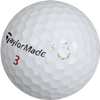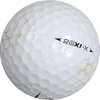University Study on Used Golf Ball Performance

Rochester, Mich. – Whether you pay $40 or $400 each time you play a round of golf, there is no denying that the sport can be an expensive pastime. Used golf balls recovered from water hazards and sold at big discounts are one way to save. Now new research offers more proof that golfers can play used balls confident they won’t hurt their game.
Dr. Thomas Raffel at Oakland University in Rochester, Mich. has obtained preliminary results providing additional evidence that used golf balls, like those sold online by the Golf Ball Divers Alliance (GBDA), perform almost exactly the same as brand new ones in all key aspects of play including total carry and total distance with roll.
The belief that used golf balls perform like new is one that has long been held by the GBDA, America’s first cooperative (co-op) of the divers who recover the balls lost in course water hazards. Many golfers feel the same, buying an estimated 100 million used balls each year. Yet, many more golfers remain skeptical.
While used golf balls have been tested in the past, the GBDA is the first to encourage an independent university study for future publication in academic journals.
This study was also the first to measure the impact of time under water, asking the question, how long is too long? In the study Dr. Raffel divided dozens of brand-new 2016 Titleist Pro V1 golf balls into groups. He saved one group
as control balls and sank the rest in cages in a 5-foot deep pond on the Oakland University Golf Course for one month, three months and five months.
All of the balls were sent to Golf Laboratories, a well-known, independent testing facility in San Diego, Calif. Golf Laboratories’ state-of-the-art computer-controlled robot player hit all of the new and used golf balls with a TaylorMade R7 425 driver. Trackman technology was used to measure distance to landing point, total distance with roll, spin, ball speed and consistency of trajectory and dispersion on the course. Complete research results including golf ball performance data can be found here.
An additional test on balls submerged for a full year is scheduled for this summer, but the GBDA is most interested in the three-month threshold. Since the GBDA dives courses twice a year or more, the average golf ball sold by the
GBDA spends three months or less underwater.
“Dr. Raffel’s research proves what members of the GBDA already believed. Golf balls submerged for up to five months perform almost identically to new ones,” said Matt Hopkins, GBDA Executive Director. “We’re out to make the great game of golf more affordable, but the co-op is about more than that.”
The GBDA protects its diver-members by ensuring fair wages for the often hazardous work they do recovering lost balls. The co-op also benefits another group – those with barriers to employment, including disabilities. Thanks to a unique partnership with Lapeer Team Work’s GO Industries, located in Lapeer, Mich. the GBDA has built a state-of-the-art golf ball processing facility employing many who wouldn’t otherwise have a job.
“Golfers can save hundreds of dollars this golf season by purchasing used golf balls,” said Hopkins. “With research to prove it, we can confidently say there’s no reason for golfers to pay more than twice as much for a golf ball that offers no appreciable difference in play.”
ABOUT THE GOLF BALL DIVERS ALLIANCE:
The Golf Ball Divers Alliance (GBDA) is a cooperative of scuba divers who retrieve millions of golf balls lost each year on America’s golf courses and offers them cleaned and packaged for resale on their website. Its mission is to use the collective resources and buying power of the group to improve the financial well-being and quality of life of its members, their families and communities. For more information visit www.golfballdivers.com.



